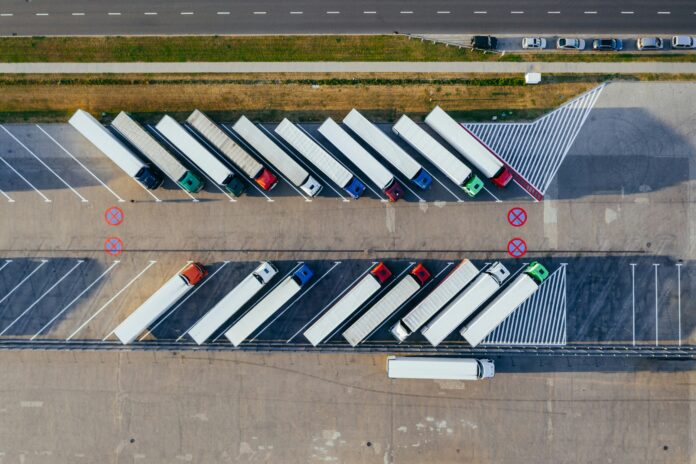
Shipping and logistics can feel overwhelming, especially with outdated systems. By 2025, technology leaders will have transformed the industry with intelligent tools like AI and IoT. This blog will explain how these advancements simplify operations and improve efficiency. Keep reading to learn what’s influencing this change.
The Importance of Digital Transformation in Shipping and Logistics
Digital advancements allow shipping and logistics companies to improve efficiency and reliability. By adopting automation, real-time analytics, and AI integration, businesses can reduce delays in transportation management.
These technologies also help improve fleet management by predicting maintenance needs and adjusting routes effectively. In turn, restaurant owners benefit from consistent delivery schedules and fresher ingredients arriving on time.
Technology-based solutions create better supply chain visibility at every stage. Data-supported decisions allow for quicker responses to disruptions like weather changes or port closures that affect deliveries.
Tools like IoT sensors ensure temperature-sensitive items stay fresh during transit, preserving the quality of perishable goods for restaurants. This shift enhances operational flexibility while reducing costs tied to outdated processes.
AI-Powered Innovations
AI tools analyze restaurant supply chain data to predict demand, reduce waste, and improve transportation management. With these systems, shipping companies can enhance delivery times and lower costs for businesses.
Smart algorithms support fleet management by mapping the fastest routes in real time. AI-driven automation also minimizes manual errors during order handling and tracking. AI helps restaurants save time and money by simplifying logistics operations.
Big Data Analytics for Smarter Decision-Making
Big data analytics helps restaurant owners make better shipping and logistics decisions. It processes large amounts of information from supply chains, transportation networks, and customer orders.
This allows businesses to identify trends, minimize delays, and manage inventory more efficiently.
Real-time analytics improves fleet management by predicting maintenance needs and refining delivery routes. Data-based decisions also reduce costs by avoiding overstocking or understocking supplies.
Sophisticated tools can monitor performance measures to ensure smooth operations throughout the entire logistics process.
Last-Mile Delivery Technologies
Delivery drones ensure quicker food shipments by avoiding traffic. These devices provide live tracking, keeping restaurant owners updated about order locations.
Self-driving vehicles lower labor costs and enhance productivity in food delivery systems. Intelligent lockers enable customers to collect meals at secure and convenient locations. Tools like Handheld POS by Peppr further simplify order management at the restaurant level, ensuring smoother transactions and faster service integration with delivery systems.
Cloud-Based Platforms for Seamless Integration
Cloud platforms connect different parts of the supply chain in real time. They allow shipping and logistics providers to combine inventory, orders, and transportation management systems through one platform.
For restaurant owners, this improves communication with suppliers and ensures faster deliveries of fresh ingredients.
These platforms support data sharing across teams for improved decision-making. For example, if a delivery delay occurs, notifications can inform businesses instantly. This minimizes operational downtime and keeps schedules on track.
Adopting technologies like blockchain further strengthens security in these systems while maintaining clarity at every stage.
Blockchain for Transparency and Security
Blockchain ensures transparency by recording every transaction in a secure ledger. In shipping and logistics, it helps track goods from suppliers to customers with real-time updates.
This can prevent fraud, reduce disputes, and verify deliveries. Smart contracts on the blockchain also automate payments when goods reach their destination.
This technology builds trust among all parties involved in the supply chain. It protects data while improving operational accuracy for restaurant owners managing supplies or deliveries.
Robotics and advanced warehousing solutions further improve these processes effectively.
Robotics and Smart Warehousing Solutions
Robots enhance efficiency in warehouse operations by managing repetitive tasks such as sorting, packing, and stacking. They minimize human error and accelerate order processing. Self-driving vehicles move goods within warehouses, saving time during busy business hours.
Advanced warehousing solutions rely on sensors and AI to monitor inventory levels instantaneously. These systems avoid overstocking or shortages of essential items for restaurants, ensuring seamless supply chain management.
Consider IoT next for real-time tracking advantages across logistics networks.
IoT and Real-Time Tracking Systems
IoT devices simplify the process of tracking shipments and monitoring deliveries as they happen. Sensors attached to packages or vehicles provide updates about their location, temperature, or condition through connected networks.
This enables restaurant owners to know precisely where ingredients are and their expected arrival time.
Real-time tracking enhances fleet management by helping drivers identify more efficient routes. Telematics systems notify managers about delays, maintenance requirements, or unexpected stops.
This increased visibility minimizes waste and ensures fresh products arrive at kitchens on schedule.
Sustainable Logistics Solutions
Businesses are adopting greener shipping methods to lower emissions and establish eco-friendly supply chains—discover additional information about these practices.
Carbon-Neutral Shipping
Carbon-neutral shipping lowers greenhouse gas emissions by employing environmentally friendly technologies and sustainable methods. Companies implement practices such as energy-saving routes, carbon reduction programs, and renewable energy sources to minimize environmental harm.
Transitioning to low-emission transportation options aids in addressing climate change while increasing supply chain efficiency. For restaurant owners, supporting these initiatives meets consumer demand for sustainability and can strengthen brand reputation.
Alternative Fuel Vehicles
Alternative fuel vehicles help decrease shipping emissions and lower operating expenses. Many logistics companies now use electric or hybrid trucks to transport goods effectively. These vehicles reduce dependence on conventional fuels like diesel, helping to minimize carbon footprints.
Natural gas-powered fleets also attract attention for their cost efficiency and cleaner operations. Hydrogen-fueled transport, though newer, holds potential in supporting more sustainable supply chain solutions.
Investing in these alternatives enhances environmental outcomes while maintaining dependable transportation management.
Cybersecurity Enhancements
Cybersecurity improvements help protect sensitive data in shipping and logistics. Cybercriminals often target digital platforms, putting systems at risk of breaches. Technology leaders enhance defenses through sophisticated threat detection tools.
These tools identify intrusions more quickly to prevent disruptions in transportation management.
Encryption protocols keep customer and company data safe during transfers between systems. Multi-factor authentication provides an additional layer of protection for access to cloud-based solutions or real-time analytics platforms.
Enhanced cyber safety ensures smoother operations while reducing risks tied to automation efforts like robotics or IoT tracking technologies.
Digital Freight Marketplaces for Efficiency
Digital freight marketplaces connect shippers with carriers directly, reducing time spent on negotiations. Restaurants can use these platforms to find cost-effective and fast shipping options for supplies.
These systems match shipments with available trucks in real-time, minimizing empty miles and reducing transportation costs.
These digital tools offer restaurants clear visibility into rates and delivery times. Businesses can track shipments in real-time through user-friendly interfaces, ensuring operational flexibility.
Predictive analytics used in the next section improves demand forecasting, further enhancing logistics planning.
Predictive Analytics for Demand Forecasting
Predictive analytics helps restaurant owners plan more effectively by relying on historical data and trends. Sophisticated algorithms examine patterns in customer demand, enabling businesses to adjust supply chains effectively.
This minimizes the risk of overstocking or shortages during peak times, conserving both time and money.
Real-time analytics improve transportation management and ensure timely deliveries for perishable goods like produce or seafood. Restaurants can prevent delays that impact food quality by forecasting demand accurately.
Autonomous vehicles in shipping enhance these capabilities even further with precise delivery systems.
Autonomous Vehicles in Shipping
Autonomous vehicles are changing transportation management by reducing shipping delays and enhancing efficiency. Self-driving trucks and drones can operate continuously, cutting delivery times significantly.
Their use also lowers operating costs by minimizing fuel waste and improving route planning through AI integration.
These vehicles provide safer operations with fewer human errors, making supply chain advancements more dependable. Automated ships and trucks reduce reliance on manual labor, addressing workforce challenges in logistics.
Advanced telematics ensures real-time visibility into fleet management systems, allowing improved tracking of shipments for restaurant owners relying on consistent deliveries.
The Role of Digital Twins in Logistics
Autonomous vehicles rely on advanced data to function efficiently. Digital twins extend this concept by creating virtual replicas of physical logistics systems, such as warehouses or transportation networks.
These digital models allow business owners to test changes in operations without interfering with real-world processes.
Restaurant supply chains benefit greatly from this technology. For example, a digital twin can forecast delays in food shipments and recommend quicker alternatives based on real-time analytics.
It aids in more efficient decision-making, minimizes waste, and ensures fresh inventory reaches its destination dependably.
API-Based Integrations for Streamlined Operations
APIs connect different systems, allowing software to exchange information instantly. They simplify transportation management by linking order systems with fleet management tools. This connection reduces errors and ensures up-to-the-minute visibility across supply chain operations.
For restaurant owners, APIs improve efficiency in delivery tracking and inventory updates. For example, an API can sync your ordering system directly with suppliers or logistics providers. This setup minimizes manual input and enhances operational accuracy while saving time for staff.
Returns and Reverse Logistics Technologies
API integrations simplify operations, but effective reverse logistics technologies help manage returns successfully. Sophisticated systems now allow restaurants to monitor returned products in real time.
These tools ensure transparency and minimize mistakes during the process.
AI-driven solutions assess return patterns and forecast future requirements. Automated handling accelerates inspections and re-shelving items, saving time for staff. Intelligent platforms also improve transportation routes to reduce costs while processing returns efficiently.
Ecosystem Integration for Enhanced Collaboration
Integrated systems now connect suppliers, distributors, and restaurant owners in real time. These data-driven connections enhance supply chain management by sharing updates on inventory levels, delivery schedules, and transportation routes instantly.
Technology like cloud-based platforms ensures all parties collaborate more effectively.
Businesses can access real-time visibility across their networks through interconnected tools. For example, telematics integrates with fleet management systems to monitor deliveries while IoT sensors track product conditions during transit. This level of transparency minimizes delays and ensures fresher goods for restaurants.
Case Study: Maersk’s AI-Driven Logistics Transformation
Maersk introduced AI-driven solutions to enhance shipping and logistics processes, prioritizing operational responsiveness. The company implemented advanced data analytics to forecast demand and improve route efficiency for its extensive fleet.
This transition reduced transit times, enhanced fuel efficiency, and lowered costs for businesses relying on global supply chains. Restaurants, especially those managing fresh produce or frozen goods, benefit from the more dependable delivery schedules these advancements create.
AI-powered systems also improved real-time tracking across Maersk’s network. Restaurant owners can now monitor shipments with greater precision using tools that provide live updates on cargo locations and conditions.
Predictive maintenance algorithms help prevent delays caused by equipment failures in transport vessels or trucks, ensuring shipments arrive as planned. Through smarter logistics management driven by artificial intelligence, many food businesses face fewer interruptions in their inventory flow.
Case Study: Flexport’s Digital Freight Forwarding Success
Flexport changed freight forwarding by integrating technology with logistics expertise. Its platform allows businesses, including restaurants, to handle shipments through real-time visibility and informed decisions based on data.
By simplifying shipment tracking and supply chain management, Flexport helped reduce costs and improve operational flexibility for its clients.
With cloud-based tools, Flexport made processes like customs clearance and inventory forecasting more straightforward. It helped restaurants plan more effectively by providing predictive insights on delivery timelines.
This method also ensured clarity throughout the transportation process while tackling challenges in fleet management and global shipping coordination.
Challenges in Adopting Advanced Logistics Technologies
Digital freight forwarding demonstrates the influence of technology, but adopting modern logistics systems comes with challenges. High initial costs often make it difficult for small businesses like restaurants to invest in tools such as AI-powered advancements or IoT solutions.
Many operators find it hard to dedicate budgets for these improvements while handling daily expenses and narrow profit margins.
Training employees on automation solutions presents another difficulty. Complex technologies require knowledgeable workers, yet many teams lack experience with data analysis or real-time monitoring platforms.
Without proper training, workforce challenges may delay integration efforts, interrupting supply chain management and transportation processes essential for restaurant operations.
Opportunities for Growth with Smarter Logistics Solutions
Overcoming challenges in advanced logistics technology creates room to explore better solutions. More intelligent logistics systems can help restaurants improve supply chain management and reduce delivery times.
AI-powered tools predict demand shifts so food items arrive fresh, cutting waste significantly. Data-informed decisions also identify faster routes for deliveries, improving fleet management and saving costs on transportation.
Restaurants benefit from automation solutions that ensure consistency in supply without overstocking or running out of key ingredients.
More intelligent logistics technologies offer real-time visibility into shipments with IoT sensors monitoring temperature-sensitive goods like produce or seafood. This ensures quality control while keeping customers satisfied with fresher meals served daily.
Blockchain improves transparency by recording every transaction securely from supplier to restaurant owner, building trust across the supply chain. Predictive analytics helps plan inventory during busy seasons such as holidays, keeping operations smooth under pressure.
These advancements ensure operational flexibility while supporting sustainable practices like energy-efficient vehicles for lower emissions during transport activities.
The Future of Shipping and Logistics Beyond 2025
Advanced automation will dominate supply chain management beyond 2025. Fully autonomous trucks and drones are expected to improve transportation processes, reducing delivery times for restaurants relying on fresh produce.
AI-driven freight management systems will predict demand more accurately, ensuring stocks move efficiently without delays or excess inventory.
Sustainable practices will play a larger role in logistics strategies. Shipping fleets might adopt alternative fuels like hydrogen or electric power to cut emissions. Real-time analytics from IoT devices could enhance fleet routes while maintaining environmental goals.
This progress promises faster deliveries, better cost efficiency, and greener operations designed to support restaurant owners’ needs.
Conclusion
Technology leaders are redefining shipping and logistics for a smarter future. They rely on AI, IoT, and data to improve efficiency and spark progress. These developments make operations faster, more sustainable, and clearer.
By addressing current challenges, they position the industry for lasting success beyond 2025.





